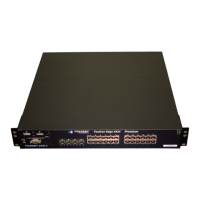Configuring IP Multicast Protocols
December 2005 © Foundry Networks, Inc. 19 - 3
Upstream: Represents the direction from which a router receives multicast data packets. An upstream router is
a node that sends multicast packets.
Downstream: Represents the direction to which a router forwards multicast data packets. A downstream router
is a node that receives multicast packets from upstream transmissions.
Group Presence: Means that a multicast group has been learned from one of the directly connected interfaces.
Members of the multicast group are present on the router.
Intermediate nodes: Routers that are in the path between source routers and leaf routers.
Leaf nodes: Routers that do not have any downstream routers.
Multicast Tree: A unique tree is built for each source group (S,G) pair. A multicast tree is comprised of a root
node and one or more nodes that are leaf or intermediate nodes.
Changing Global IP Multicast Parameters
The following configurable parameters apply to PIM-DM, PIM-SM, and DVMRP.
• Maximum number of PIM or DVMRP groups – You can change the maximum number of groups of each type
for which the software will allocate memory. By default, Layer 3 Switches support up to 1024 PIM groups and
1024 DVMRP groups.
• Internet Group Membership Protocol (IGMP) V1 and V2 parameters – You can change the query interval,
group membership time, and maximum response time.
• Hardware forwarding of fragmented IP multicast packets – You can enable the Layer 3 Switch to forward all
fragments of fragmented IP multicast packets in hardware.
Changing Dynamic Memory Allocation for IP Multicast Groups
Layer 3 Switches support up to 1024 PIM groups and 1024 DVMRP groups by default. Memory for the groups is
allocated dynamically as needed. For each protocol, previous releases support a maximum of 255 groups and
255 IGMP memberships.
NOTE: The number of interface groups you can configure for DVMRP and PIM is unlimited; therefore, the
system-max dvmrp-max-int-group and the system-max pim-max-int-group commands that define their
maximum table sizes have been removed.
The software allocates memory globally for each group, and also allocates memory separately for each interface’s
IGMP membership in a multicast group. An interface becomes a member of a multicast group when the interface
receives an IGMP group membership report. For example, if the Layer 3 Switch learns about one multicast group,
global memory for one group is used. In addition, if three interfaces on the device receive IGMP group
membership reports for the group, interface memory for three IGMP memberships also is used.
Since the same group can use multiple allocations of memory (one for the group itself and one for each interface’s
membership in the group), you can increase the maximum number of IGMP memberships, up to 8192.
NOTE: The total for IGMP memberships applies to the device, not to individual interfaces. You can have up to
8192 IGMP memberships on all the individual interfaces, not up to 8192 IGMP memberships on each interface.
Increasing the Number of IGMP Membership
To increase the number of IGMP membership interfaces you can have for PIM, enter commands such as the
following:
FastIron SuperX Router(config)# system-max pim-max-int-group 4000
FastIron SuperX Router(config)# write memory
This command enables the device to have up to 4000 IGMP memberships for PIM.

